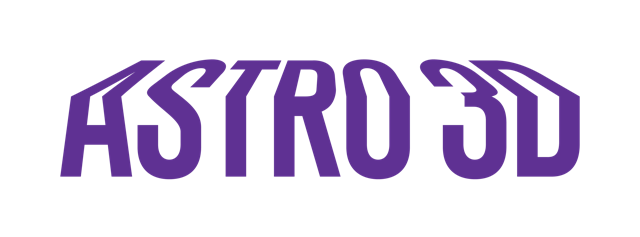February 2021
Editor: Tristan Reynolds
Foreword
Tristan Reynolds
Welcome to the February 2021 edition of the WALLABY newsletter. I hope this finds everyone well. The WALLABY team has been busy in the past half a year. We have had the second internal data release of the Hydra field and the internal release of kinematic models for 15 galaxies in the first Hydra field data release. There are now numerous papers being circulated among the team and being submitted to journals.
In this issue, we have an update on the latest pilot ASKAP observations, the completion of Pilot Phase 1 and reports from several technical working groups. We also have profiles on 8 new WALLABY members who joined since last August. I provide an update on the work I’m leading investigating ram pressure stripping in the Hydra cluster galaxy ESO 501-G075. We have updates from Technical Working Groups 1, 3, 4, 5 and 7 and Science Working Groups 1, 2, 3, 4 and 5. Happy reading!
Message from the PI
Lister Staveley-Smith
It’s now almost a year since the last face-to-face WALLABY busy week and almost a year since the conclusion of our Pilot survey observations. WALLABY has been fortunate in that data processing by the CSIRO operations team, and post-processing by our own team has been able to continue without too much interruption during the pandemic. As reported below by Tobias and Karen, this is leading to a stream of research papers being prepared and submitted. Slightly more delayed has been the transition to Pilot phase 2 and survey observations, but planning for those is now being finalised. I’d like to commend the huge amount of ‘behind-the-scenes’ activities of some our technical working groups in processing Pilot data, and preparing for the post-processing of phase 2 and survey data. Much of their effort does not necessarily lead to direct publications, but is hugely important for supporting the broader science team. The kinematics working group, the source-finding working group and the new WALLABYcat working group have all put in a huge effort since the last newsletter to provide the team with high-quality data and workflow designs. Congratulations!
Message from the project manager
Tobias Westmeier
The WALLABY project has just completed an important milestone: with the processing and imaging of the Norma field finalised, all three WALLABY pilot survey fields have now been fully imaged, which completes phase 1 of ASKAP pilot observations.
In December 2020 the source finding working group was able to release the catalogue, images and spectra of about 270 galaxies across the entire Hydra pilot survey field. Source catalogues and images for the NGC 4636 and Norma fields will follow soon, although we are still facing a few issues with continuum artefacts that are expected to have some impact on the reliability and completeness of the resulting catalogues.
The kinematics working group led by Kristine Spekkens has been able to provide the team with the first kinematic models and rotation curves of 15 spatially resolved Hydra DR1 galaxies, with more galaxies from Hydra DR2 and the other two fields expected to become available later this year.
Meanwhile, preparations for phase 2 of ASKAP pilot survey observations, which are expected to begin in early 2021, are under way. Phase 2 will have a strong focus on commensality between different survey science projects in an attempt to reduce the overall observing time required for the ASKAP surveys. While commensal observing will take up some of the time allocated to each of the SSPs, we will still be left with enough extra time to select five fields that are of specific scientific interest to WALLABY.
Another highlight of the past six months was the WALLABY science workshop held in November 2020. The workshop was attended by more than 50 team members from around the world. While the main focus was on the presentation of some of the first scientific results from the Eridanus and Hydra (pre-)pilot survey data, there was also plenty of time for discussion sessions on topics such as simulations, the availability of multi-wavelength data and the field selection process for phase 2 of ASKAP pilot survey observations. Our intention is to hold such science workshops on a more regular basis from now on, as many science teams are ramping up their activities in anticipation of more data to become available this year.
Message from the project scientist
Karen Lee-Waddell
As the final stages of the WALLABY Pilot Survey Phase 1 are wrapping up, team members are busily analysing science data. Already, a couple of papers on the Eridanus (pre-pilot) and Hydra fields have been submitted and several more papers are being circulated among co-authors.
Looking back on the years of significant effort from the ASKAP, WALLABY, and other ASKAP survey science team members to commission, test, and improve various aspects of the telescope and its data processing pipeline, I feel a huge sense of pride (and relief) that so much WALLABY science has been enabled and that papers are continually being published.
Nevertheless, moving forwards there is still a lot of work that has to be done as we prep for Pilot Survey Phase 2 and eventually full science. TWG2 is eagerly finding suitable targets for Phase 2, focusing on areas of sky that will work well with current ASKAPsoft processing parameters/methodology and contain ample potential for HI science.
From both a science and technical perspective, it is a great time to be involved in WALLABY! I am inspired by all the recent and upcoming achievements of everyone involved and truly excited about the future of this survey.
New Member Profiles
Sarah Brough
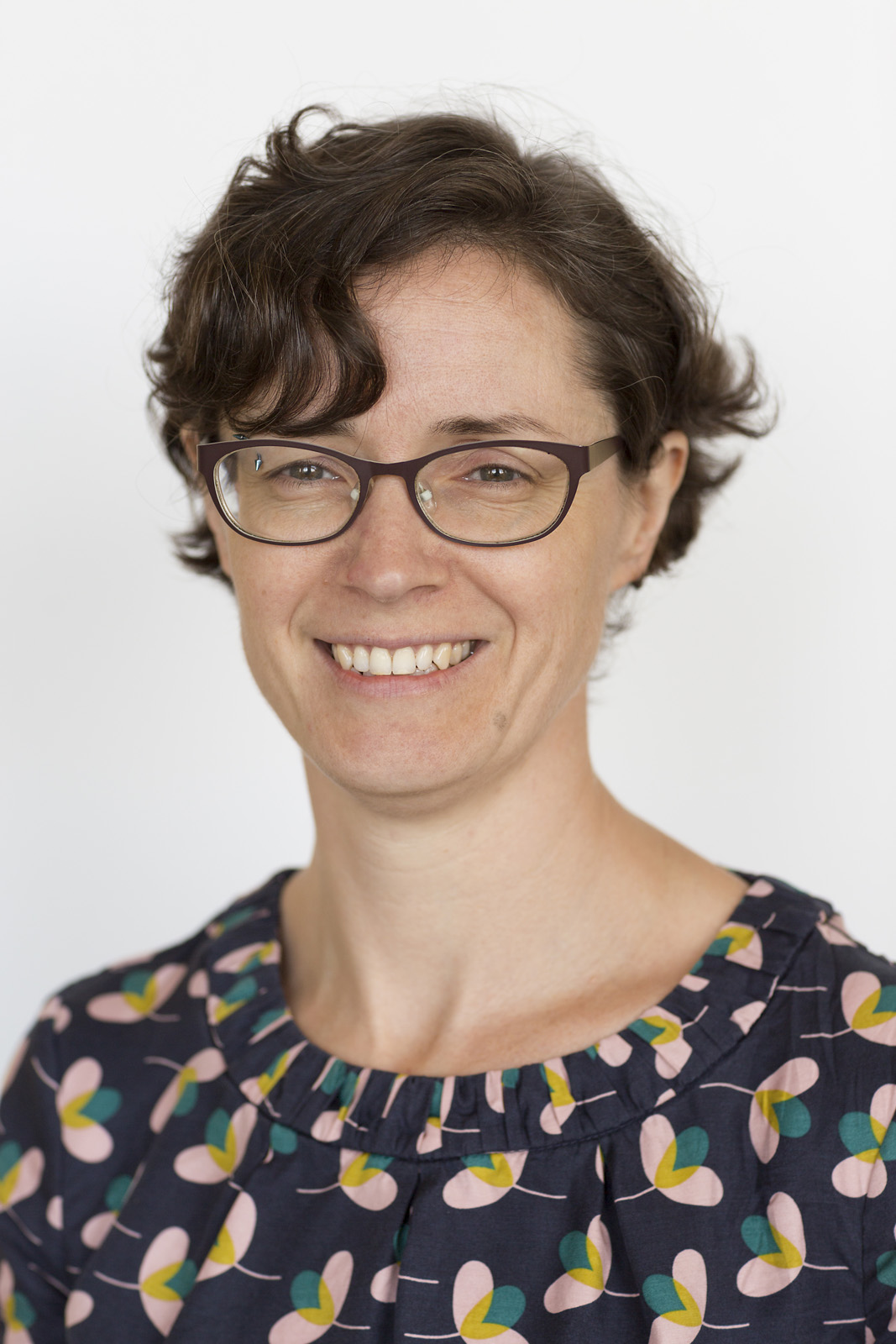
I’m a Professor at UNSW and my research mainly focusses on galaxy evolution in the local universe, using optical facilities. I am particularly interested in the most massive galaxies in the Universe, which represent the most extreme result of galaxy formation. Which might make you ask why I’ve joined WALLABY? More recently my massive galaxy research led me to the upcoming Legacy Survey of Space and Time (LSST, https://www.lsst.org). LSST will be the dominant optical survey facility over the next decade when it starts its ten-year survey of the Southern hemisphere sky in 2023, a bit like WALLABY. LSST’s capability to see really faint light has increased my interest in low surface brightness astronomy’s potential to help us understand more about galaxy evolution, for example through galaxy tidal tails and streams. Which leads me to WALLABY. As I’m really curious to know what you all find out about the gas content of these features with WALLABY.
Outside of research I am a former chair of the Astronomical Society of Australia’s Inclusion Diversity and Equity in Astronomy Chapter, and have been a keen advocate for diversity in science including as Associate Dean of Equity, Diversity and Inclusion at UNSW Science in 2020. I also have an eight year old son who I enjoy spending time with and I’ve been learning to surf the last few years which gives me a regular opportunity for some perspective.
Claude Carignan
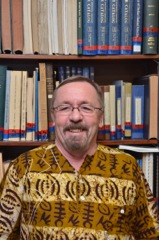
I am emeritus professor in the department of Astronomy of the University of Cape Town. I am also emeritus professor at the Université de Montréal and adjunct professor at the Université de Ouagadougou, in Burkina Faso. My main research interest is the study of dark matter in spiral and dwarf irregular galaxies using HI synthesis and optical Fabry-Perot interferometry observations. This allows, by constructing mass models, to study the density distribution of dark matter in galaxies.
Recently, I have been working on HI observations obtained with KAT-7, the precursor of MeerKAT, the South African SKA pathfinder. We are now getting ready for the first early science observations with MeerKAT that should start in mid-2017 and preparing the MHONGOOSE survey, due to start with he full MeerKAT array around mid-2018. I have also been involved in the development of large EMCCD detectors for photon counting applications. The first scientific CCD282 should be delivered around March 2016.
Brent Groves
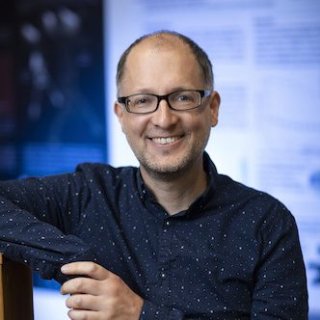
Dr. Brent Groves became a Senior Research Fellow at the International Centre for Radio Astronomy Research at the University of Western Australia in 2019. Brent completed his PhD at the Research School of Astronomy & Astrophysics at the Australian National University in 2005, then moved to Europe where he was a Research Fellow at the premier astronomy institutes in Europe, inclue the Max Planck Institute. In 2015, Brent returned to Australia as a Future Fellow at ANU, before begining the next stage of his research here at UWA.
Brent is an internationally known expert in the physics of the interstellar medium and dust, specifically looking at the heating and cooling of this diffuse phase in the Universe in star-forming regions and in Active Galactic Nuclei powered by supermassive black holes. Brent has used many of the key observatories including the Herschel and Hubble Space Telescopes, and the 8m-class VLT at the European Southern Observatory, as well as Australian Telescopes such as the 3.9m AAT, and the Australian Telescope Compact Array.
I’m specifically interested in SWG3 (looking at the nearby galaxy population and the cross over with other nearby galaxy surveys, following the work I’ve already done with THINGS, HERACLES, SINGS, KINGFISH PHANGS, etc.) and also SWG5 (multi-wavelength synergies, such as looking at the association with all the ancillary data, again using my existing knowledge of the large area surveys that cross the WALLABY survey area).
Rebecca Halloran
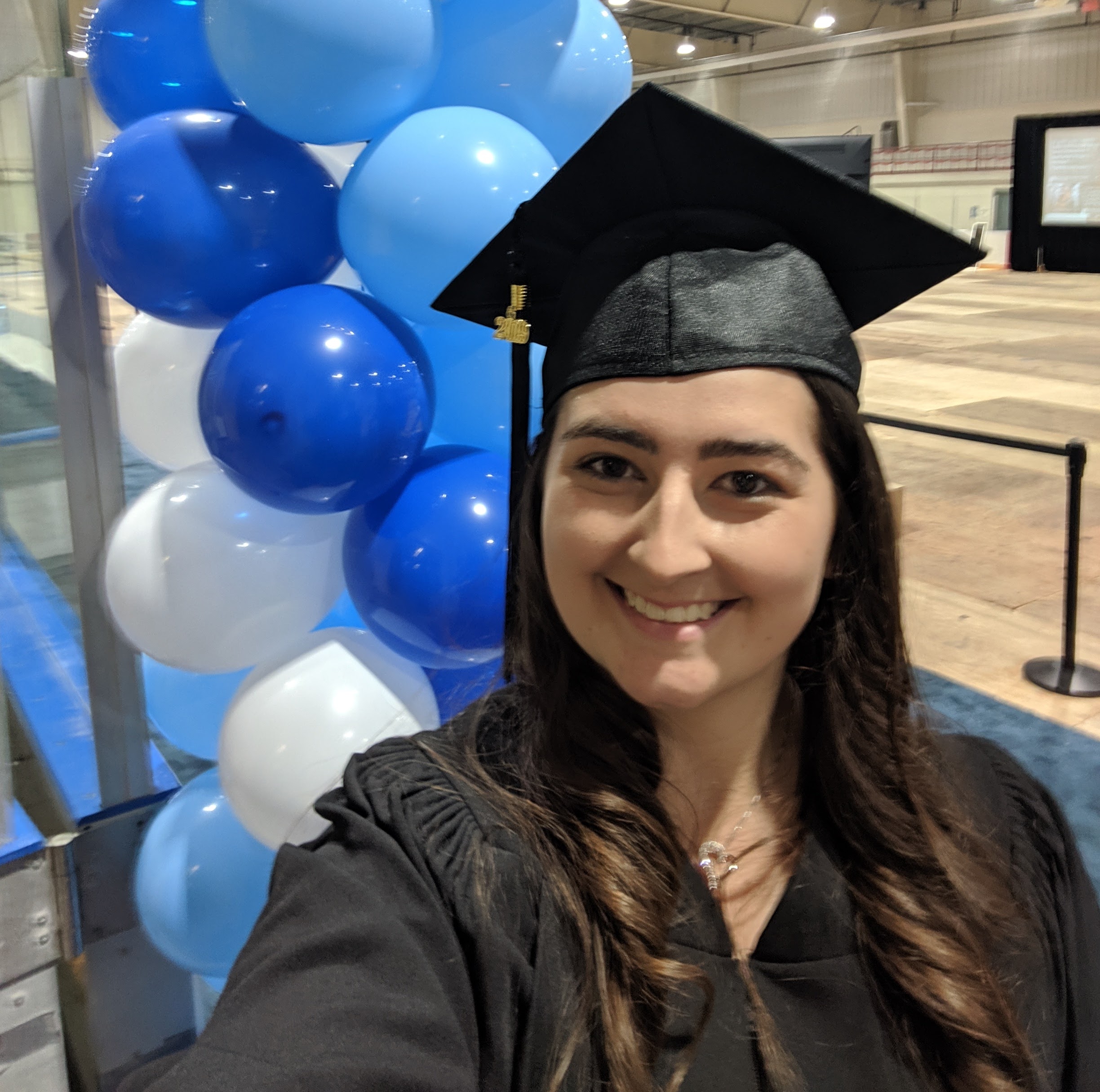
I am very excited to have the opportunity to work with such a diverse and knowledgeable group of individuals in the WALLABY team. I completed my undergrad degree at University of Ontario Institute of Technology which is now known as Ontario Tech. University in Oshawa, Ontario, Canada. I graduated with Honours majoring in physics, minoring in maths and specializing in astronomy.
I am very fortunate to now be working on my master’s degree at Queen’s University in Kingston, Ontario, Canada, with Kristine Spekkens. My thesis will focus on kinematic modelling of resolved WALLABY detections in the context of measuring a velocity function for these objects. I look forward to taking this opportunity to expand my knowledge and attain some results that may give answers or lead us to ask more questions.
Enrichetta Iodice
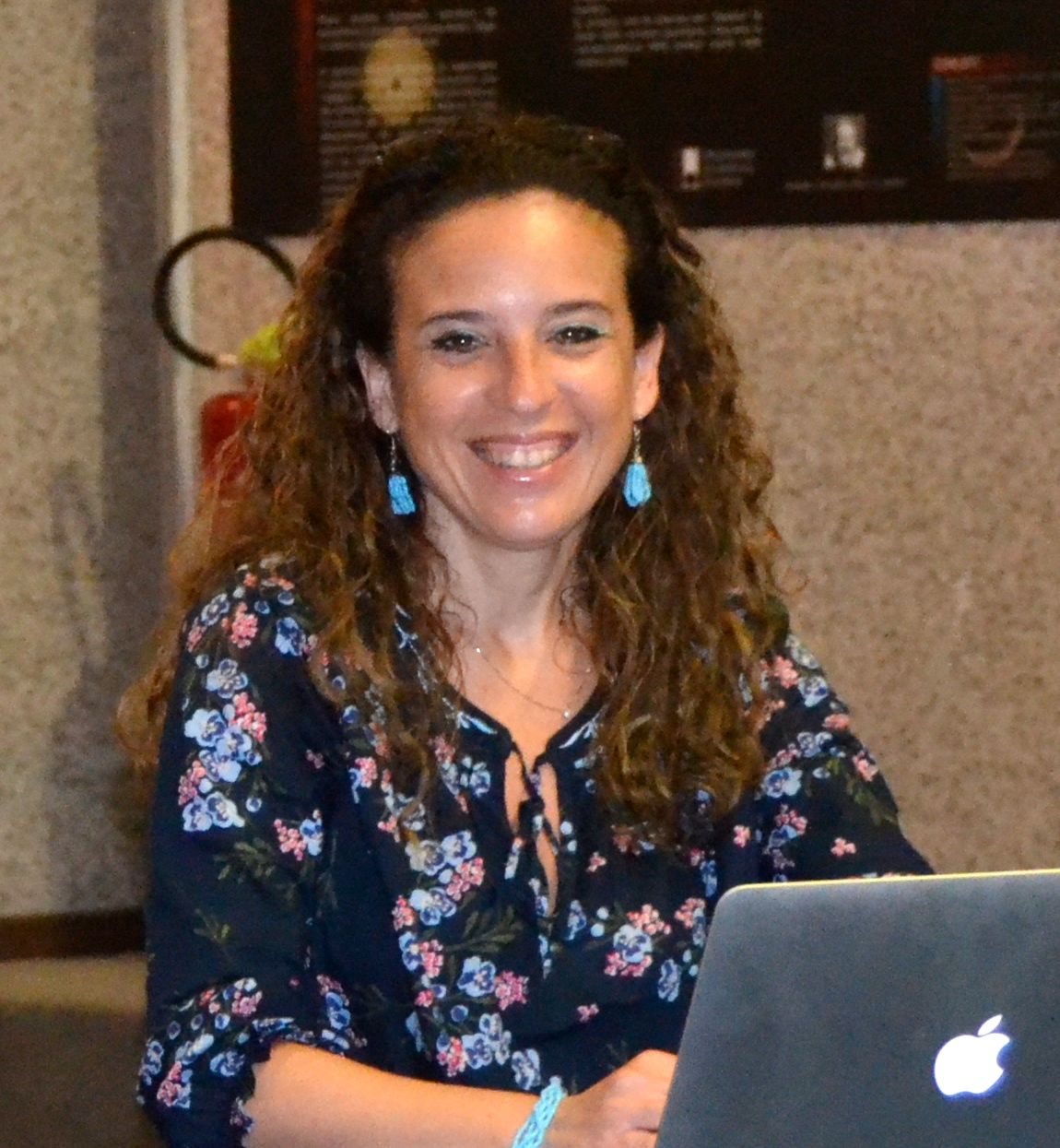
I received my PhD in 2001 in Astrophysics at the International School for Advanced Studies of Trieste, Italy. My scientific research is in the extragalactic field. It focuses on both observational and theoretical aspects of structure, formation and evolution of galaxies, including peculiar and interacting systems, in different environments based on imaging and spectroscopy.
I was invited to join WALLABY project by Paolo Serra (INAF-OA Cagliari, Italy) since we are interested in combining the deep optical images from the VST Early-type galaxy Survey (VEGAS, which I am leading) with the new radio detection from WALLABY. The deep optical images would represent the ideal counterpart to these radio data. The main aim is to search for optical low surface brightness (LSB) counterparts of the faint HI features, like tails or clouds, across different environments (from clusters of galaxies to voids) in the local universe. Coupling the optical and HI data is crucial to understand the relative importance of hydrodynamical and tidal forces in shaping galaxies, as a function of the environment where they reside. Therefore, my main contribution could be in the data analysis, looking for the optical counterpart in the radio maps. I joined SWG2 and SWG3, and the technical TWG2 and TWG4.
Kyle Oman

I am a postdoctoral research associate at the Institute for Computational Cosmology, Durham University. I completed my PhD at the University of Victoria in 2017, and spent two years as a postdoc at the Kapteyn Institute in Groningen before moving to Durham in 2019. I’m interested in the gas kinematics of dwarf galaxies, and how this can be used to constrain the gravitational potential and so the dark matter content and structure of these objects. My background is in theory and numerical simulations: my PhD (University of Victoria, 2017) involved making detailed mock 21-cm “observations” of dIrrs from the APOSTLE hydrodynamical cosmological simulations and comparing with the LITTLE THINGS survey data. That mock observing code is now publicly available as MARTINI.
I’m excited to join WALLABY TWG1 to support the survey science with detailed mocks as needed – please don’t hesitate to get in touch if you’re looking to connect your work with these sorts of theoretical predictions! I’m also looking forward to working with (both the spatially resolved and un-resolved) WALLABY HIVFs and exploring what these might be able to tell us about cosmology, dark matter, and galaxy formation. Finally, I’m curious to see what the kinematics in the nearby, spatially well-resolved dwarfs in WALLABY will look like. I hope that the extremely straightforward selection function and reasonably large numbers of objects will allow us to better understand the diverse, and often messy, members of this population.
Fei Qin
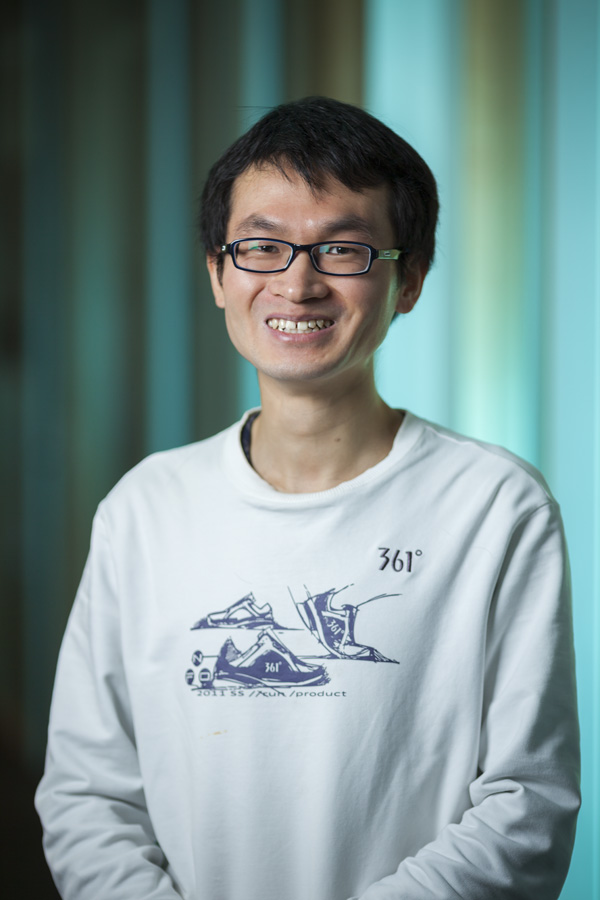
I’m a postdoctoral research fellow in Korea Astronomy and Space Science Institute. I am excited to be part of the WALLABY project and join the TWG1, SWG2 and SWG4 groups. I am a former ICRAR/UWA PhD student too.
My current research focuses on the cosmic flow measurements, two-point correlation and power spectrum measurements, density field reconstruction, halo occupation distribution (HOD) and mock sampling algorithm. I also work on developing new techniques to offset the measurements biases caused by the non-Gaussianity of peculiar velocities in galaxy surveys.
A new research project I’m currently leading is developing the HOD and mock sampling algorithm for WALLABY and making simulation predictions for WALLABY. I currently work with Prof. David Parkinson (KASI), Dr. Cullan Howlett (UQ), Dr. Adam Stevens (ICRAR/UWA), Dr. Garima Chauhan (ICRAR/UWA and Prof. Lister Staveley-Smith (ICRAR/UWA) on this project. We are interested in studying how many HI-galaxies obey the Tully-Fisher relation, and the biases caused by the section effects of galaxy types. We are also interested in developing a more accurate method to reconstruct the density and velocity fields of the nearby universe using WALLABY mocks.
Faisal Rahman
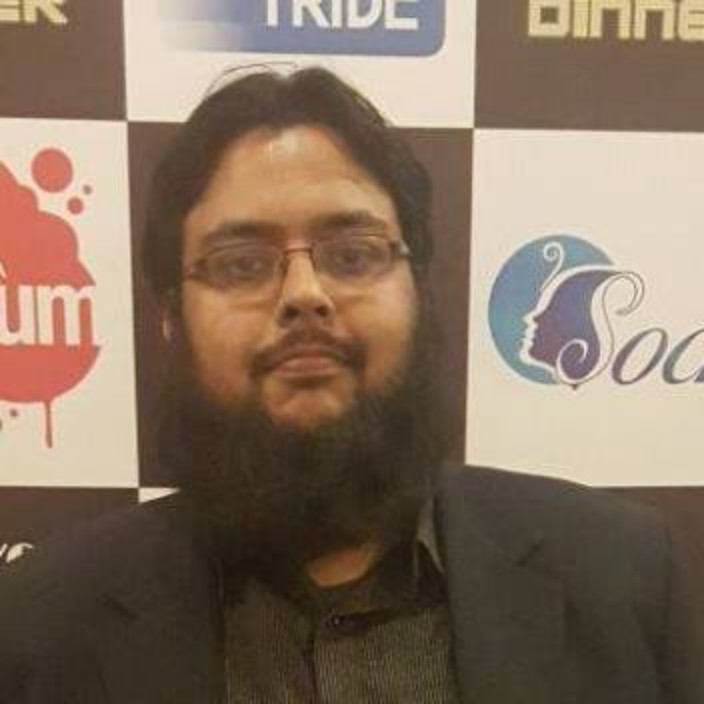
I am Syed Faisal ur Rahman, I am a PhD student at University of Karachi (UoK) and I am expected to graduate this year. My PhD title is “Constraining dark energy through distance ladders and continuum surveys” for which I worked with Prof. Jeremy Mould (Swinburne) and Prof. Jawed Iqbal (University of Karachi).
I joined WALLABY in the second half of 2020 and I have also been involved with EMU-ASKAP for the past few years. I did my Master of Studies from Australian National University (ANU) with subjects in Mathematics and Astronomy. Before that I was working in industry as a software developer. I did my BSc in Telecommunication Engineering from National University of Computer and Emerging Sciences (FAST-NUCES).
I am interested in cosmology, radio astronomy (HI and continuum), scientific computing, machine learning and statistics of the large scale structures in our universe. I am particularly interested in the studies involving the Hubble constant measurements, dark energy equation of state, peculiar velocities, clustering, galaxy bias and the CMB cold spot. With WALLABY, I am mainly involved with SWG4 “Cosmology & Statistical Studies”. I am mainly interested in cosmological parameter constraints using redshift space galaxy clustering and peculiar velocities. I am also interested in survey design strategy and technical aspects of the full WALLABY survey as I think this will be a great learning opportunity for me. However, I am always open to new interesting problems.
Ram Pressure Stripping of Hydra Cluster Galaxy ESO 501-G075
by Tristan Reynolds
In this work we investigate ram pressure stripping on the Hydra cluster galaxy ESO 501-G075 using observations from Hydra data release 1 (DR1). We identify 51 galaxies detected in HI within the projected virial radius (Rvir) of Hydra (Fig. 1), with five galaxies spatially resolved by > 5 synthesised beams (Fig. 2). Two of these galaxies display large morphological asymmetries. One lies at a projected distance of < 0.1 Rvir and shows signs of ram pressure stripping. The other is ESO 501-G075 which lies nearer the virial radius (projected distance ~0.8 Rvir) and has a line of sight velocity relative to the cluster that is near the cluster escape velocity. ESO 501-G075 is likely in the early stages of falling into the cluster and we investigate environmental processes that could be responsible for its disturbed HI morphology. We rule out tidal interactions, as ESO 501-G075 has no nearby neighbours within ~0.34 Mpc. We use a simple model to determine that ram pressure can remove gas from the disc at radii > 25 kpc. We conclude that, as ESO 501-G075 has a typical HI mass compared to similar galaxies in the field and its morphology is compatible with a ram pressure scenario, ESO 501-G075 is in the early stages of experiencing ram pressure. We have submitted this work to MNRAS and are currently revising the paper draft for resubmission.
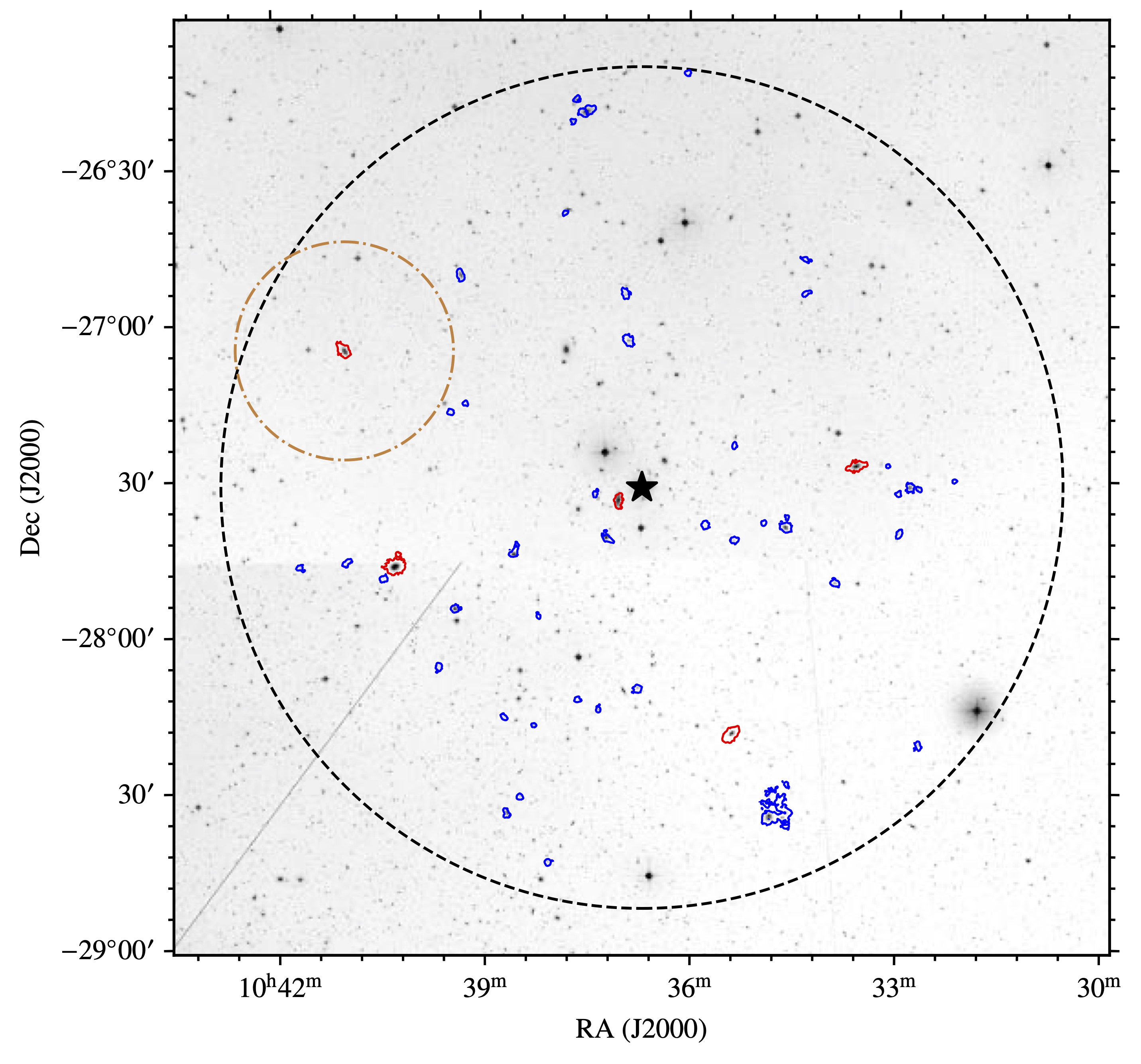

TWG 1 – Numerical Simulations and Mock Surveys
by Adam Stevens
Is it time for another newsletter already? My goodness, six months have flown by!
First: a huge congratulations to Garima Chauhan on submitting her PhD thesis!! Garima has been — and continues to be — an active member of the theory branch of the WALLABY team. Her latest paper — the third from her thesis research, which includes several other WALLABY co-authors — performs a detailed forward-modelling of the HI-halo mass relation that would be detected by the ALFALFA and DINGO surveys. Most importantly, she compares directly to the actual data from those surveys, highlighting why one cannot simply take an intrinsic scaling relation from a simulation and expect it to lineup with observational data. The lesson, as always, is that mock observation is crucial! The methods Garima has developed will be paramount to the inference of the HI-halo mass relation from WALLABY.
Meanwhile, mock galaxy catalogues from our two premier semi-analytic models of galaxy formation — Dark Sage and Shark — are being used to forecast and test the infrastructure for deriving the two-point correlation function signal from WALLABY with errors. This is being done in close conjunction with SWG4. The physical mocks provide the base from which thousands of statistical mocks will be generated, needed to account for cosmic variance. Stay tuned for further updates on this ongoing project.
Many of you might have also seen the recent Eridanus WALLABY paper led by Ivy Wong, which highlights the existence of two dark galaxy candidates. My personal contribution to this project has been to search for analogues of these systems in the main IllustrisTNG simulation and study their formation histories. Sure enough, we found 3 galaxies in the simulation that were very closely matched to the Eridanus dark galaxy candidates’ properties. If the theory holds, these “galaxies” may have formed in the early Universe, with almost no evolution in the last 10 Gyr, continually lacking the necessary pressure to convert their cold gas into any appreciable stellar mass. And if so, we may start to find them in WALLABY in much greater abundance!
In other news, we welcomed Kyle Oman as a new member to TWG1 in recent months. Kyle is a postdoc at Durham University. Among other endeavours, he is known for the development of the MARTINI code, which turns hydrodynamic-simulation data into synthetic HI data cubes.
Wishing everyone a productive and vaccinated 2021!
TWG 3 – Data Processing, Imaging and Quality Control
by Jonghwan Rhee and Bi-Qing For
Data Processing
Data processing for all the pilot phase I fields (Hydra cluster, NGC 4636 group, Norma cluster) have been completed. However, several issues were found in the processed data, particularly in NGC 4636 group and Norma cluster. Bright continuum sources (e.g. 3C273) in NGC 4636 field left strong sidelobe artefacts of the PSF across the entire area, which hampered appropriate continuum imaging and subtraction. Thus, this issue made blind source finding using SoFiA unfeasible for the field, thereby impacting some pilot survey science such as the environmental effect study on HI mass function. Norma cluster has the same technical issue due to a bright continuum source in one of the two tiles covering the Norma field. In contrast, the other tile showed good quality except for some solar interference artefacts. TWG 3 is investigating processing strategy to properly deal with the impact of bright continuum sources and solar interference.
Data Validation
For the data validation sub-working group, we are currently adding new metrics for the pilot survey data. The data validation script will continue to be modified/developed along with each new round of data processing. A readme file is being written up for explaining each of the metrics in the HTML validation report. We will include this readme file in future CASDA distribution. In the meantime, if you have any question regarding these metrics and have suggestions, please feel free to contact Bi-Qing.
TWG 4 – Source Finding and Cataloguing
by Tobias Westmeier on behalf of TWG 4
TWG 4 has started to routinely run the SoFiA 2 source finding pipeline on WALLABY pilot survey data to produce source catalogues, images and spectra for internal release to the WALLABY team. In December 2020, we were able to release the source catalogue for the full Hydra field. SoFiA 2 detected the HI emission from about 270 galaxies across that field, and the resulting moment 0 image from SoFiA is shown in Fig. 3. The map reveals spectacular filaments of galaxies, with the Hydra cluster itself being visible as the concentration of galaxies in the left half of the map.
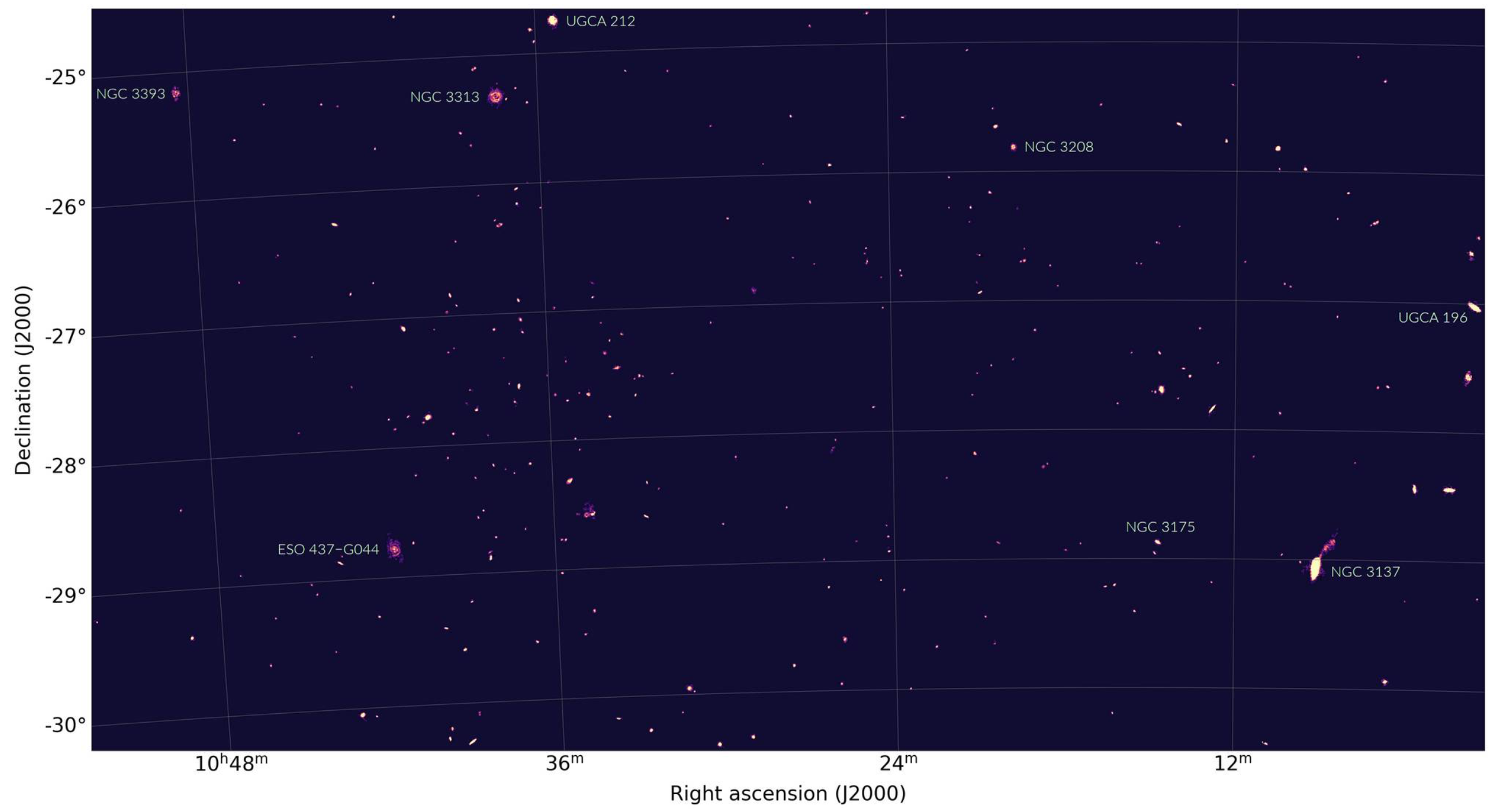
Over the past few months we have made several improvements to SoFiA 2 which have been helpful in processing WALLABY data affected by commonly encountered artefacts. This includes the implementation of a filter for removing bandpass ripples from data cubes prior to source finding. In addition, several options for dealing with the effects of residual continuum emission have been implemented, including the ability to provide a list of continuum source positions to SoFiA 2 to ensure that those sources are either flagged prior to source finding or prevented from affecting SoFiA’s reliability filter. All of these new features have made the pipeline far more robust, thus allowing us to obtain more reliable and complete source catalogues from imperfect ASKAP data.
A paper describing the SoFiA 2 source finding pipeline has been submitted to a peer-reviewed journal and is currently under review. In addition to describing the structure and algorithms of the pipeline, the paper describes its performance in terms of speed, memory usage, completeness and reliability of the resulting catalogue, and accuracy of basic source parameters measured by SoFiA 2. Once published, we hope that the paper will become a useful reference for users seeking to better understand the fundamental performance metrics of SoFiA’s algorithms.
Lastly, an international team of source finding enthusiasts around the core SoFiA development team is participating in the new SKA Science Data Challenge 2 which has just been released. The main purpose of the challenge is to detect as many galaxies as possible in a large, simulated SKA HI data cube and measure their basic parameters as accurately as possible. Having extensive experience with the processing of large SKA precursor and pathfinder data cubes, our team should be in a good position to tackle the challenge, and we have already been able to assist the SKA Office with identifying and fixing a few minor issues with the data cube that were found during test runs of SoFiA.
TWG 5 – Kinematics Pipeline
by Kristine Spekkens and Se-Heon Oh
Kinematic Models
Over the past few months, the focus of Technical Working Group 5 (TWG5) has been to generate kinematic models of resolved Hydra Pilot Survey detections in order to test modelling techniques and enable science by WALLABY members. A number of these detections are amenable to kinematic modelling, and the approach is to use existing 2D and 3D algorithms to fit rotating disk models to their HI morphologies and kinematics. These kinematic models are complemented by photometric models of GALEX NUV and PanSTARRS optical imaging also being carried out within TWG5. Internal releases of these models are now available to all WALLABY team members through the wiki.
Kinematic models have been insofar released for 15 Hydra DR1 objects. The basic modelling approach consists of optimizing 3D rotating disk models to the data using both the 3DBarolo (Di Teodoro & Fraternali 2015, MNRAS, 451, 3021) and FAT (Kamphuis+ 2015, MN 452 3139) algorithms, using mean values from and discrepancies between the models to best-fitting parameters and their uncertainties, and generating mean model datacubes using the new MGCSuite algorithm (Spekkens+ 2021, in prep). 2D models generated by BAYGAUD+2DBAT (Oh+ 2019, MN 485 5021; Oh+ 2018, MN 473 3256) are also being distributed, and may provide useful constraints on the better-resolved systems. This approach is being expanded to model DR2 detections, and continues to prove reliable at estimating rotation curve amplitudes and disk geometries for detections that are spatially resolved by as few as 2-3 beams across the major axis and S/N ~ 1-2 per pixel. This implies that the number of WALLABY detections for which the disk structure can be constrained could be significantly higher than previously predicted using a 5-beam threshold (e.g. Koribalski et al. 2020).
TWG5 will continue to distribute kinematic models to the WALLABY team as new Pilot Survey data are internally released, with a focus on distributing models in which rotation curves and disk geometries are homogeneously and reliably constrained as soon as possible after the data are available. Future work for TWG5 includes developing reliable geometric corrections for measured surface density profiles in the marginally-resolved regime, automated selection of modelling candidates from source finder outputs, and the development of a rudimentary password-protected archive from which to distribute models and cubelets.
TWG5 would appreciate feedback on the utility of the models distributed to the team so far. Suggestions for improvement would be particularly useful: if you have a science case that requires a rotating disk model, please get in touch! In addition, WALLABY members who wish to join TWG5 to contribute to this effort are always welcome. Regular updates regarding TWG5 activities and meetings are posted on the WALLABY wiki. Stay tuned!
BAYGAUD
Se-Heon Oh has been developing a tool, the so-called BAYGAUD (Oh et al. 2019) for gas profile decomposition based on a Bayesian Markov Chain Monte Carlo (MCMC) technique. Recently, Min-Su Kim, a graduate student working with Se-Heon Oh at Sejong University in South Korea has developed a GUI for BAYGAUD which makes it much easier for use. It allows one to generate moment maps together with a quick profile check with multiple Gaussian fits which are then used for the initial set-up of the BAYGAUD parameters. A snapshot of the BAYGAUD GUI together with its example outputs extracted using a WALLABY galaxy, WALLABY_PS_Hya_DR1_J103725_251918 is shown in Fig. 4 and 5. We plan to release the GUI version of BAYGAUD for WALLABY internal use soon.
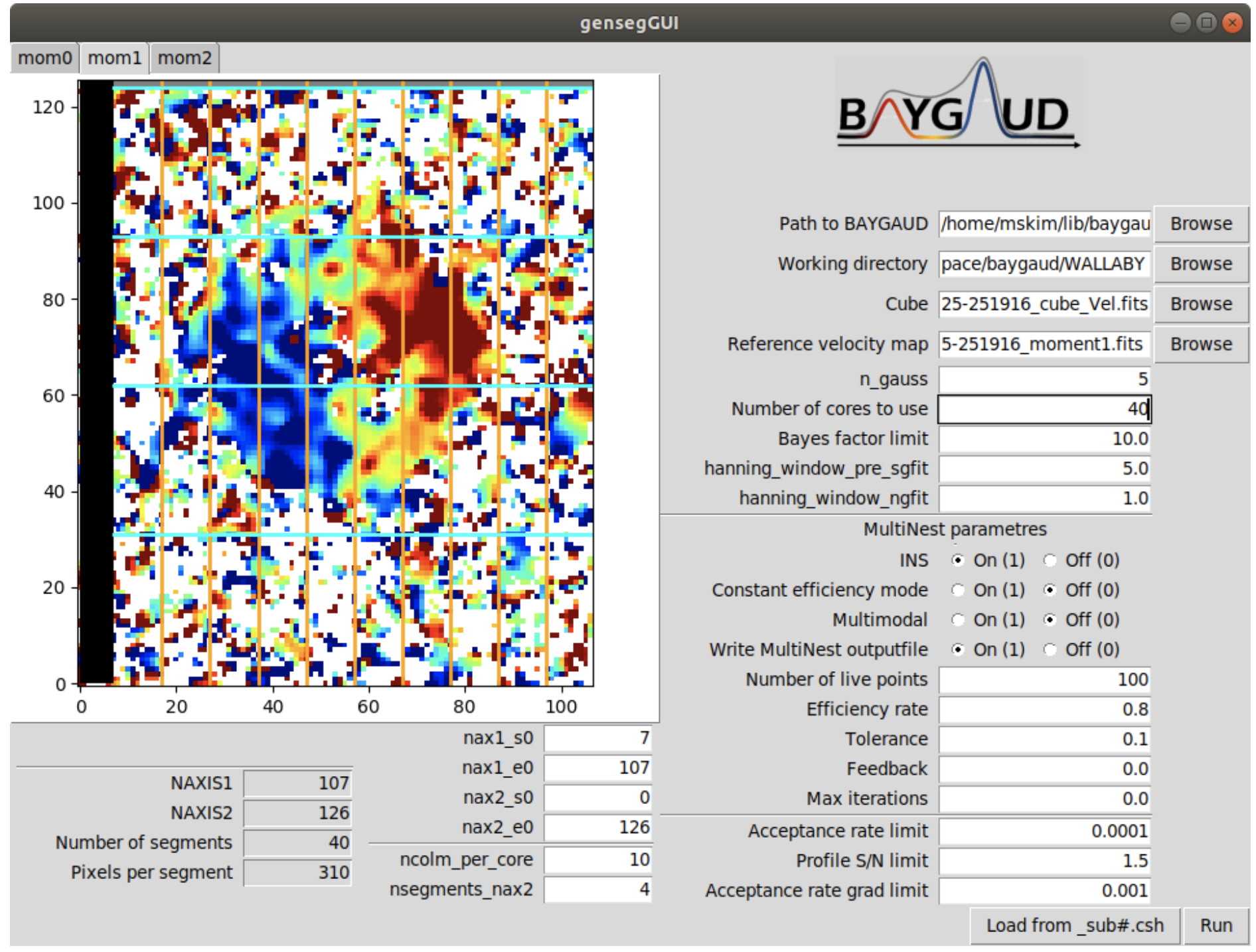
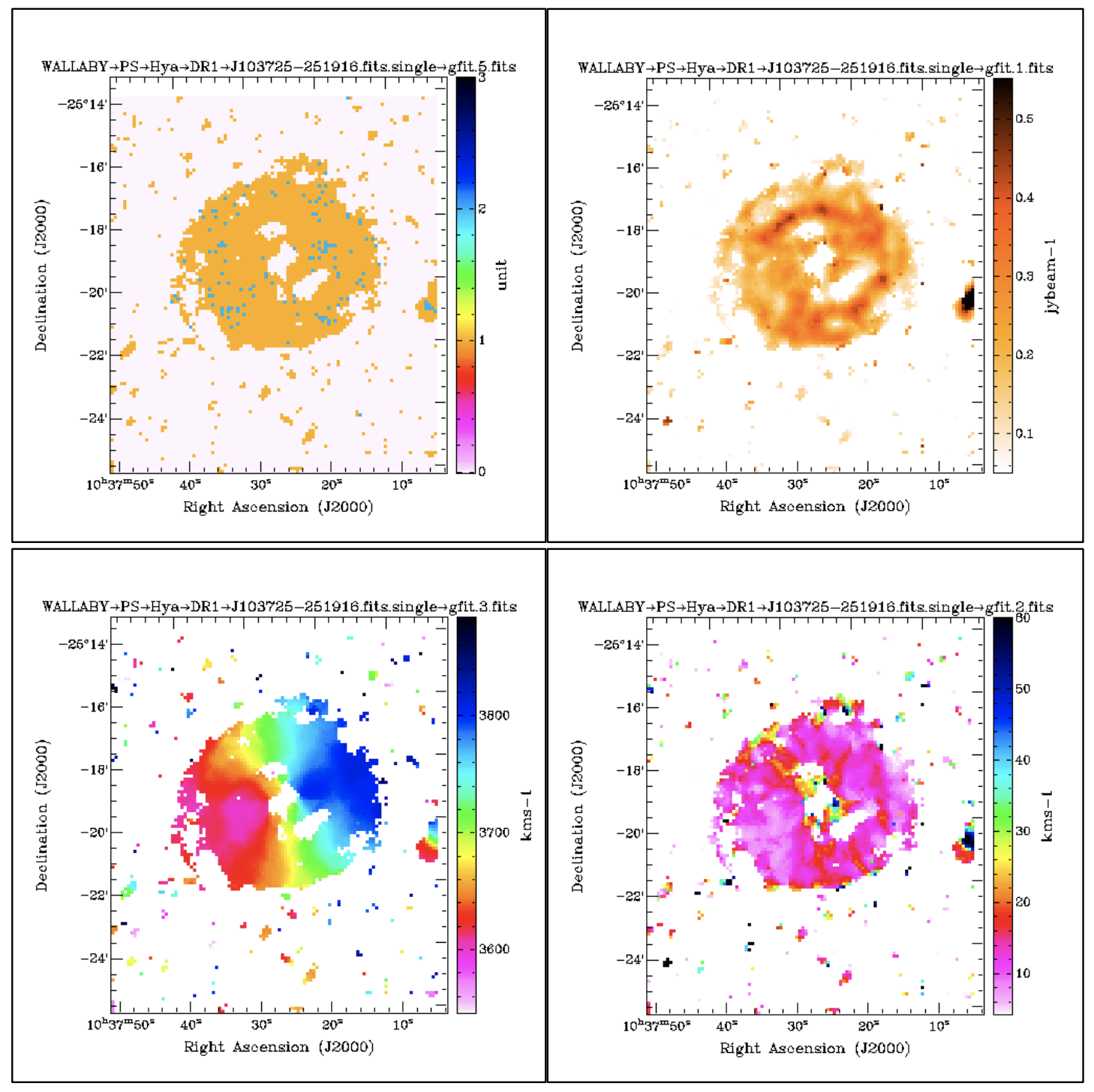
TWG 7 – WALLABY Cat
by Tristan Reynolds
The initial focus of TWG7 was on the creation of the WALLABY database. The scope of TWG7 has been expanded to now cover the full post processing pipeline that will be used take the level 5/6 spectral line cubes from CASDA and produce the value added level 7 data products that will be stored in the WALLABY database. These level 7 data products include the SoFiA source finding outputs, models produced by the kinematics working group and multi-wavelength cutouts and source properties.
The current work within TWG7 has been on database replication so as to have duplicates of the WALLABY database in Australia (AusSRC), Canada (CIRADA) and Spain (SKA regional centre). Database duplication will enable different parts of the post processing workflow to be run in different locations (e.g. source finding by AusSRC and kinematics pipeline by CIRADA) on local copies of the database. The database copies in other locations will then be updated once each post processing task finishes.
With the release of Hydra data release 2, Tobias has identified a number of additional requirements and improvements to the source finding. These primarily relate to issues arising from finding HI sources detected in previous source finding runs, in this case sources found in Hydra DR1 vs DR2. These issues are the reason Hydra DR2 was not released through the WALLABY database as they had to be dealt with manually outside of the database. A related improvement is dealing with galaxies who’s HI is detected by SoFiA as two components (e.g. shredding in optical source finding). Sources identified via visual inspection as belonging to the same galaxy will be merged together. TWG7 is currently working on implementing these changes, which will enable future releases of SoFiA data products to be done through the WALLABY database.
SWG 1 – Galactic HI and High Velocity Clouds
by Helga Dénes and Bi-Qing For
Since the last newsletter, we have improved the flagging strategy used for processing the channels with Galactic HI. We now have a separate, linearly mosaicked image cubes for each of the pilot fields. Fig. 6 shows a peak intensity map of all three data cubes. The Norma field, which is at the lowest Galactic latitude (b~-7o), shows the brightest Galactic HI emission. The NGC4636 field clearly has some problems related to the strong continuum sources in the field. The assessment of the data quality is currently underway.
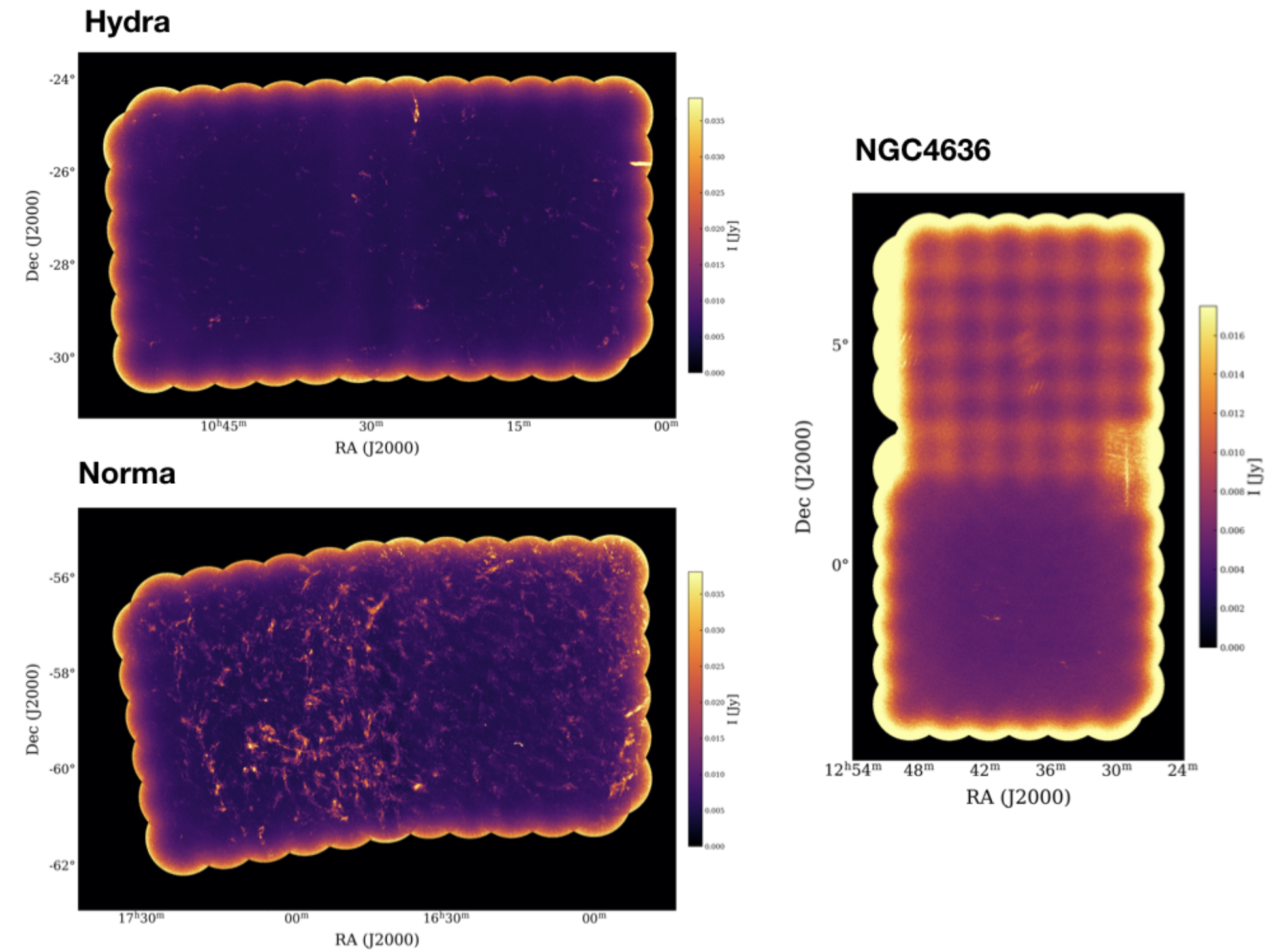
SWG 2 – Local Volume
by Se-Heon Oh and Ivy Wong
Since our last update in August 2020, many of us in the WALLABY SWG 2 team have been busy putting together some of the papers that we proposed for the pre-pilot Eridanus and the pilot Hydra observations. Since our working group primarily works in the Local Volume, we will focus on updates from the Eridanus pre-pilot observations. These pre-pilot observations are centred on the Eridanus/NGC 1395 group of galaxies that is currently falling into the NGC 1407 sub-cluster (the nominal core of the Eridanus supergroup or cluster). Fig. 7 shows the SoFiA-generated moment 0 map of these Eridanus observations.
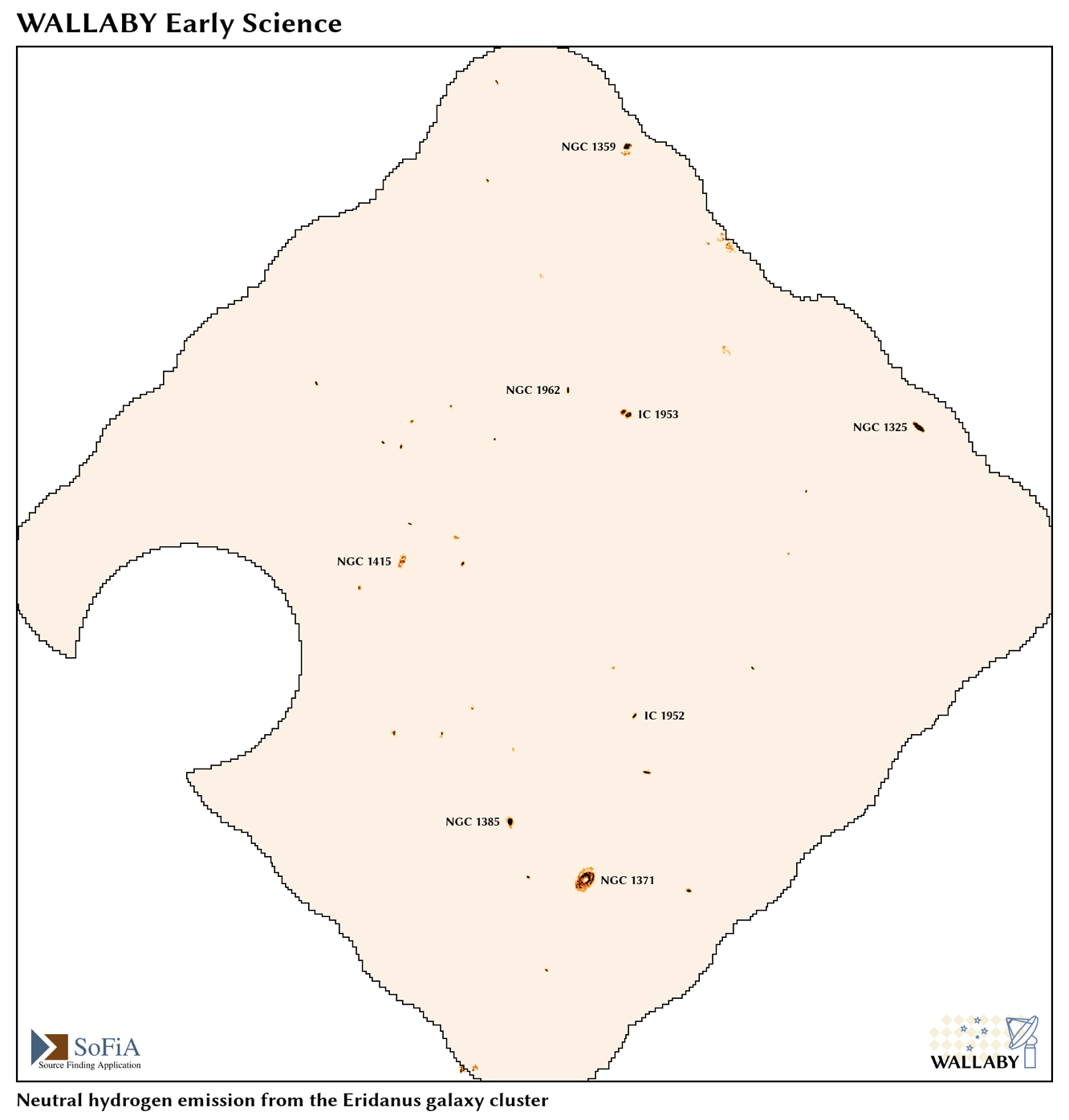
Bi-Qing is currently preparing the paper that describes these Eridanus pre-pilot observations and catalogue. The results from this paper will provide excellent insights into the performance of ASKAP for HI surveys of the Local Volume.
In December 2020, Chandra submitted the first paper from the Eridanus pre-pilot observations that studies the effects of angular momentum and environment on the HI gas and star formation properties of galaxies within the NGC 1395 group. The results from this paper suggest that there are significant amounts of pre-processing within this group prior to cluster entry.
More recently, Ivy circulated the first paper draft on two Eridanus HI clouds that do not have obvious optical counterparts due to their chance projected alignment with a background early-type galaxy and a foreground Galactic star. Ivy thanks everyone for the excellent feedback that she has received thus far and is working on the many outstanding suggestions. What is immediately clear is that this paper is unlikely to provide the final word on these two clouds but has already instigated plans for several follow-up studies.
Shinjeong Kim, a graduate student working with Se-Heon Oh at Sejong University in South Korea has been working on the effect of gas dynamics on galaxy properties in cluster environment. She performed HI gas profile decomposition of the 22 resolved galaxies from the ASKAP Hydra DR1 and 61 galaxies from the Local Volume HI Survey (LVHIS; Koribalski et al) using a newly developed tool, the so-called BAYGAUD in a quantitative manner. The kinematically decomposed HI gas components are then correlated with other physical properties of the galaxies such as star formation rate, gas and stellar mass, dynamical mass etc (see Fig. 8). Particularly, the kinematically cold gas components of the visually identified interacting galaxies are found to be relatively higher or lower than those of the isolated ones, which show a negative correlation with the dynamical mass in general. We further examine how the relative fractions of HI components of the galaxies in different kinematic phases vary with the cluster environment. In the phase-space diagram of the cluster galaxies, it is likely that both the cold HI gas components have been depleted as the host galaxies settled into the cluster’s potential.
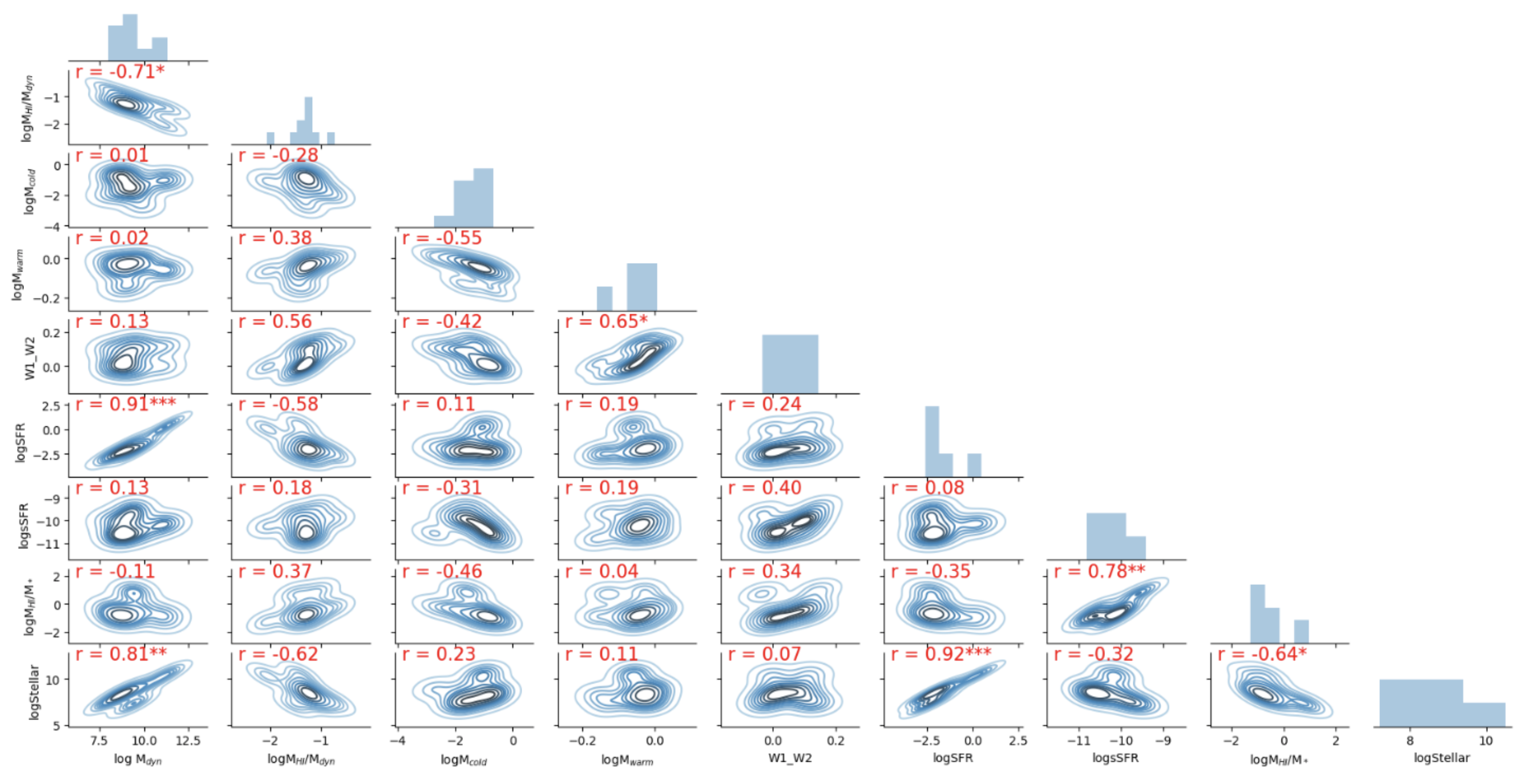
SWG 3 – The Local Universe
by Jing Wang and Barbara Catinella
Members of SWG3 are taking advantage of WALLABY pilot observations of the Hydra cluster to investigate environmental effects.
For the first time, the Hydra cluster has been mapped in HI out to twice its virial radius R200, down to an HI mass detection limit of 108.2 Msun. This yielded detections of 105 members or infalling galaxies, at least 27 of which are spatially resolved (Fig 9). ASKAP is already demonstrating its power in statistically sampling HI of galaxies at a moderate spatial resolution.
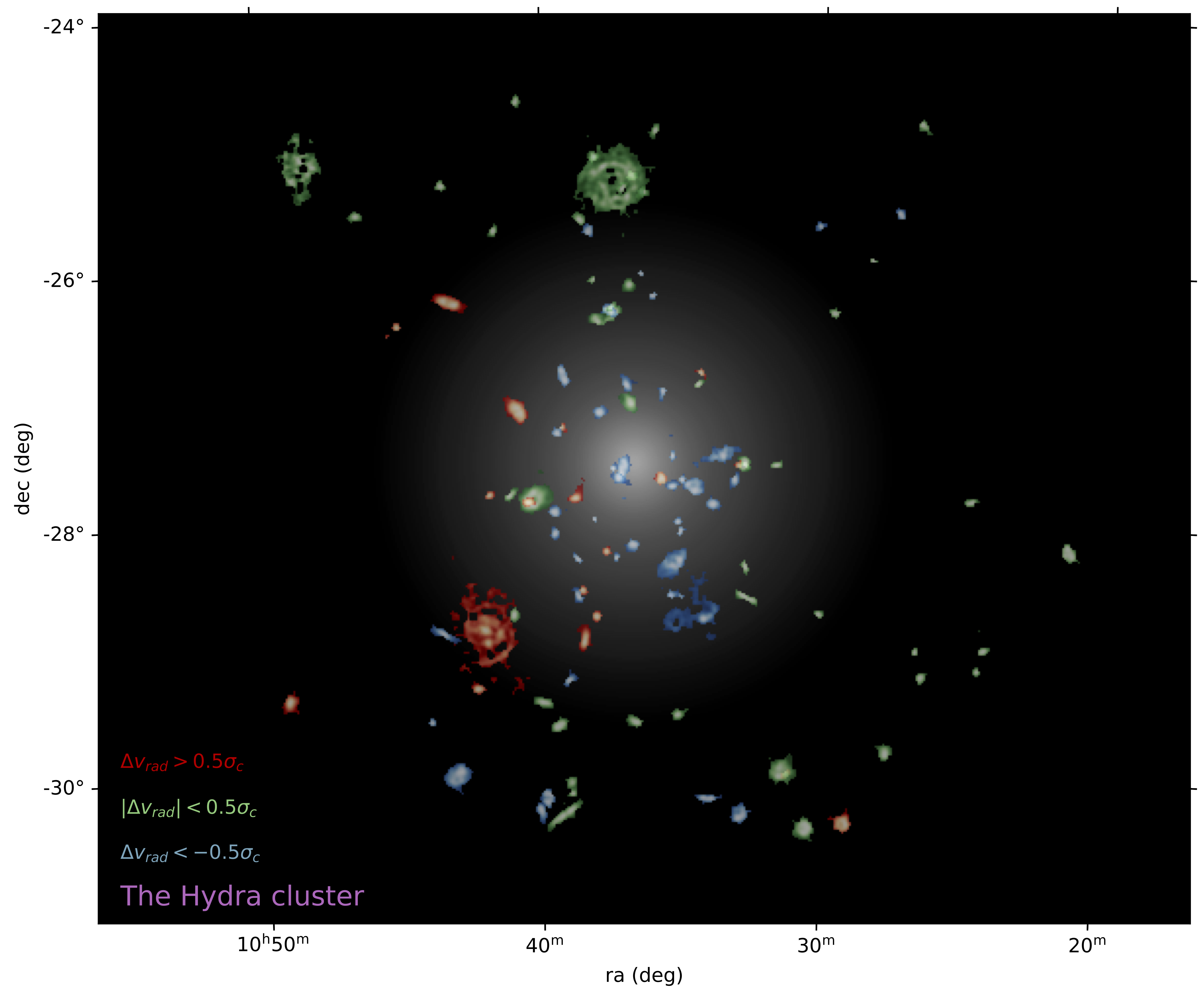
In a paper in preparation, Jing Wang and collaborators are trying to gain insight into the physics of cluster processing at a relatively early stage, when the infalling galaxies are still relatively HI rich. They attempt to quantify the instantaneous speed of HI loss due to ram pressure stripping (RPS) in the detected galaxies, by quantifying the level of ram pressure due to the intracluster medium and the observable mass of the strippable HI. They find that almost 2/3 of the detected galaxies within 1.2 R200 may be under RPS, but the level of ram pressure and thus the instantaneous HI loss rate differ widely among them. As a result, for many of the HI rich, infalling galaxies, RPS may accompany them for a long way after their infall: it may start in a galaxy at a cluster centric distance ~ 1.25 R200, but only significantly deplete the whole HI disk when the galaxy gets close to the pericenter. These results highlight the potentially important role of weak RPS in shrinking the gas reservoir of star formation during galactic evolution.
One of the resolved galaxies, ESO 501-G075, is further investigated in detail by Tristan Reynolds et al. (submitted), based on a comprehensive modelling of the kinematics of the HI gas. Further details are provided above.
SWG 4 – Cosmology and Statistical Studies
by Cullan Howlett
Like much of the WALLABY science, work within SWG4 over the last 6 months has revolved around making use of the exciting first pilot survey data. There are two main SWG4 pilot survey projects: 1) Measuring the HI mass function in the range of environments covered by the pilot survey (led by Tobias Westmeier), and 2) Producing a new Tully-Fisher template from the three cluster fields (led by Tao Hong).
On the data side, the HI mass function project has been focusing on the Hydra field, how best to recombine sources that are split into multiple parts by SoFiA-2 during source-finding, and the even more tricky problem of when one of those parts then falls below the detection threshold of WALLABY. Now that the Norma and NGC4636 fields will soon be available, similar tests and corrections will be applied to them. Preliminary mass functions are being produced as you read, so watch this space!
On the subject of WALLABY detection limits and obtaining the HI mass function, there has also been a lot of work on a ‘mock challenge’, looking at how well different methods and codes for recovering the mass function perform given simulated WALLABY-like data. The first round of this challenge, using a simulated WALLABY catalogue of ~500,000 galaxies showed good agreement between the various methods for a flux limited survey, but some differences to iron-out once more realistic S/N and redshift cuts are applied. Future efforts will work to resolve this, and look into incorporating measurement uncertainties. The end goal is a set of well validated codes for measuring the mass function from the full suite of exquisite data WALLABY will obtain.
Finally, those involved in the Tully-Fisher project have been working on providing accurate cross-matches to photometric data, with a pipeline in place and already applied to Hydra, and ready to go for Norma and NGC4636. A new algorithm for measuring the HI linewidth and W50 is also in place, with potential for importing into SoFiA-2. The first Tully-Fisher diagram for the Hydra cluster was produced recently, and we’re looking forward to seeing the results for the rest of the pilot survey data!
SWG 5 – Multi-wavelength and ASKAP Survey Synergies
by Luca Cortese and Li Shao
SWG5 would like to remind all team members interested in producing or simply using multiwavelength information for WALLABY targets to use the SWG5 wiki page as first point of reference https://pm.atnf.csiro.au/askap/projects/sup-wallaby/wiki/WALLABY_SWG5. Here you will find what’s current available and what team members are working on. In particular, many thanks to Tom Jarrett and Ned Taylor who have already provided homogenous stellar masses and/or star formation rates for Hydra DR1. Optical photometry and stellar masses for DR2 should soon be available as we are currently working on finalising the documentation associated with the data products. For any questions, please feel free to get in touch with your SWG5 coordinators.
Upcoming Meetings
2021 March 11: WALLABY Bi-monthly Science Meeting on the second Thursday of the month (online/virtual attendance)
2021 March 15-19: A Precursor View of the SKA Sky (SKA Observatory, online/virtual attendance)
